fuel additives CHEVROLET SSR 2003 1.G Owners Manual
[x] Cancel search | Manufacturer: CHEVROLET, Model Year: 2003, Model line: SSR, Model: CHEVROLET SSR 2003 1.GPages: 374, PDF Size: 2.55 MB
Page 237 of 374
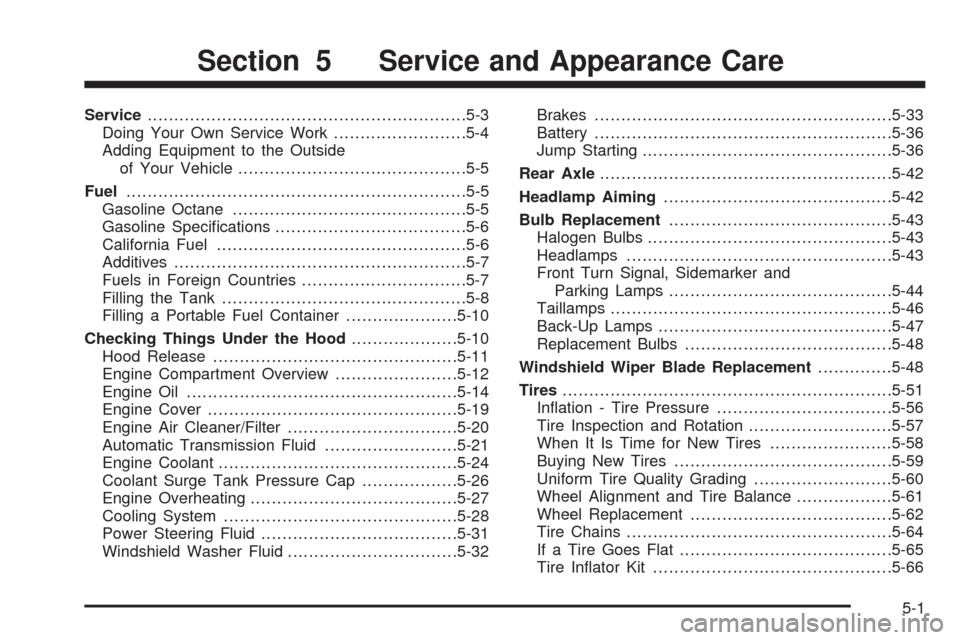
Service............................................................5-3
Doing Your Own Service Work.........................5-4
Adding Equipment to the Outside
of Your Vehicle...........................................5-5
Fuel................................................................5-5
Gasoline Octane............................................5-5
Gasoline Speci�cations....................................5-6
California Fuel...............................................5-6
Additives.......................................................5-7
Fuels in Foreign Countries...............................5-7
Filling the Tank..............................................5-8
Filling a Portable Fuel Container.....................5-10
Checking Things Under the Hood....................5-10
Hood Release..............................................5-11
Engine Compartment Overview.......................5-12
Engine Oil...................................................5-14
Engine Cover...............................................5-19
Engine Air Cleaner/Filter................................5-20
Automatic Transmission Fluid.........................5-21
Engine Coolant.............................................5-24
Coolant Surge Tank Pressure Cap..................5-26
Engine Overheating.......................................5-27
Cooling System............................................5-28
Power Steering Fluid.....................................5-31
Windshield Washer Fluid................................5-32Brakes........................................................5-33
Battery........................................................5-36
Jump Starting...............................................5-36
Rear Axle.......................................................5-42
Headlamp Aiming...........................................5-42
Bulb Replacement..........................................5-43
Halogen Bulbs..............................................5-43
Headlamps..................................................5-43
Front Turn Signal, Sidemarker and
Parking Lamps..........................................5-44
Taillamps.....................................................5-46
Back-Up Lamps............................................5-47
Replacement Bulbs.......................................5-48
Windshield Wiper Blade Replacement..............5-48
Tires..............................................................5-51
In�ation - Tire Pressure.................................5-56
Tire Inspection and Rotation...........................5-57
When It Is Time for New Tires.......................5-58
Buying New Tires.........................................5-59
Uniform Tire Quality Grading..........................5-60
Wheel Alignment and Tire Balance..................5-61
Wheel Replacement......................................5-62
Tire Chains..................................................5-64
If a Tire Goes Flat........................................5-65
Tire In�ator Kit.............................................5-66
Section 5 Service and Appearance Care
5-1
Page 243 of 374
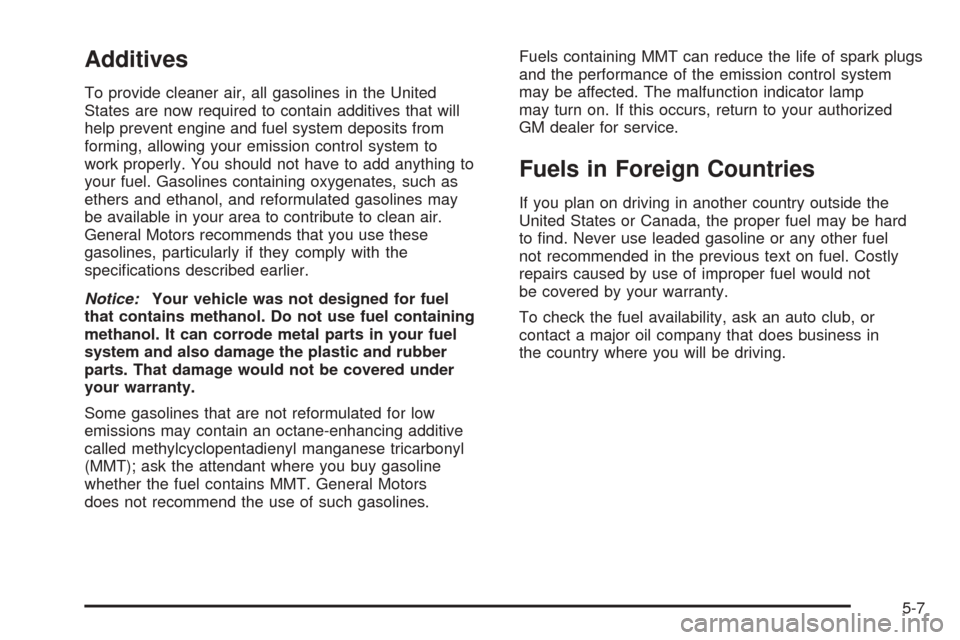
Additives
To provide cleaner air, all gasolines in the United
States are now required to contain additives that will
help prevent engine and fuel system deposits from
forming, allowing your emission control system to
work properly. You should not have to add anything to
your fuel. Gasolines containing oxygenates, such as
ethers and ethanol, and reformulated gasolines may
be available in your area to contribute to clean air.
General Motors recommends that you use these
gasolines, particularly if they comply with the
speci�cations described earlier.
Notice:Your vehicle was not designed for fuel
that contains methanol. Do not use fuel containing
methanol. It can corrode metal parts in your fuel
system and also damage the plastic and rubber
parts. That damage would not be covered under
your warranty.
Some gasolines that are not reformulated for low
emissions may contain an octane-enhancing additive
called methylcyclopentadienyl manganese tricarbonyl
(MMT); ask the attendant where you buy gasoline
whether the fuel contains MMT. General Motors
does not recommend the use of such gasolines.Fuels containing MMT can reduce the life of spark plugs
and the performance of the emission control system
may be affected. The malfunction indicator lamp
may turn on. If this occurs, return to your authorized
GM dealer for service.
Fuels in Foreign Countries
If you plan on driving in another country outside the
United States or Canada, the proper fuel may be hard
to �nd. Never use leaded gasoline or any other fuel
not recommended in the previous text on fuel. Costly
repairs caused by use of improper fuel would not
be covered by your warranty.
To check the fuel availability, ask an auto club, or
contact a major oil company that does business in
the country where you will be driving.
5-7
Page 253 of 374
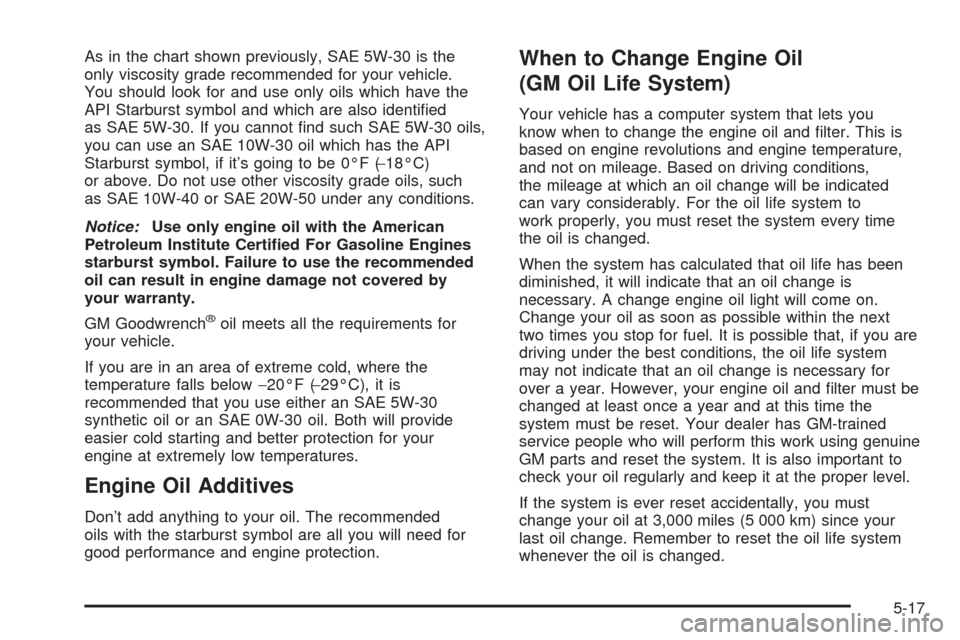
As in the chart shown previously, SAE 5W-30 is the
only viscosity grade recommended for your vehicle.
You should look for and use only oils which have the
API Starburst symbol and which are also identi�ed
as SAE 5W-30. If you cannot �nd such SAE 5W-30 oils,
you can use an SAE 10W-30 oil which has the API
Starburst symbol, if it’s going to be 0°F (−18°C)
or above. Do not use other viscosity grade oils, such
as SAE 10W-40 or SAE 20W-50 under any conditions.
Notice:Use only engine oil with the American
Petroleum Institute Certi�ed For Gasoline Engines
starburst symbol. Failure to use the recommended
oil can result in engine damage not covered by
your warranty.
GM Goodwrench
®oil meets all the requirements for
your vehicle.
If you are in an area of extreme cold, where the
temperature falls below−20°F (−29°C), it is
recommended that you use either an SAE 5W-30
synthetic oil or an SAE 0W-30 oil. Both will provide
easier cold starting and better protection for your
engine at extremely low temperatures.
Engine Oil Additives
Don’t add anything to your oil. The recommended
oils with the starburst symbol are all you will need for
good performance and engine protection.
When to Change Engine Oil
(GM Oil Life System)
Your vehicle has a computer system that lets you
know when to change the engine oil and �lter. This is
based on engine revolutions and engine temperature,
and not on mileage. Based on driving conditions,
the mileage at which an oil change will be indicated
can vary considerably. For the oil life system to
work properly, you must reset the system every time
the oil is changed.
When the system has calculated that oil life has been
diminished, it will indicate that an oil change is
necessary. A change engine oil light will come on.
Change your oil as soon as possible within the next
two times you stop for fuel. It is possible that, if you are
driving under the best conditions, the oil life system
may not indicate that an oil change is necessary for
over a year. However, your engine oil and �lter must be
changed at least once a year and at this time the
system must be reset. Your dealer has GM-trained
service people who will perform this work using genuine
GM parts and reset the system. It is also important to
check your oil regularly and keep it at the proper level.
If the system is ever reset accidentally, you must
change your oil at 3,000 miles (5 000 km) since your
last oil change. Remember to reset the oil life system
whenever the oil is changed.
5-17
Page 359 of 374
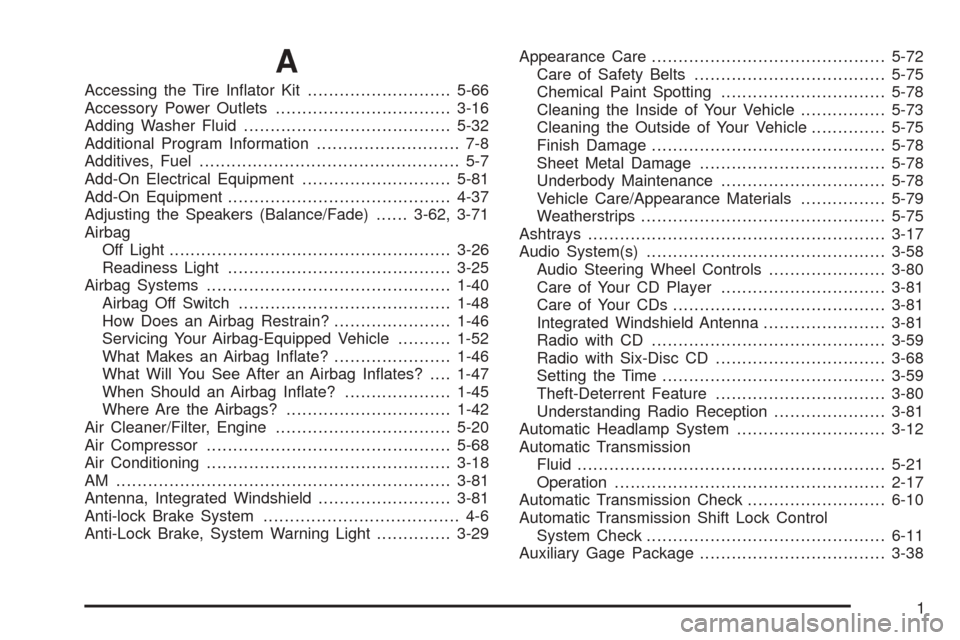
A
Accessing the Tire In�ator Kit...........................5-66
Accessory Power Outlets.................................3-16
Adding Washer Fluid.......................................5-32
Additional Program Information........................... 7-8
Additives, Fuel................................................. 5-7
Add-On Electrical Equipment............................5-81
Add-On Equipment..........................................4-37
Adjusting the Speakers (Balance/Fade)......3-62, 3-71
Airbag
Off Light.....................................................3-26
Readiness Light..........................................3-25
Airbag Systems..............................................1-40
Airbag Off Switch........................................1-48
How Does an Airbag Restrain?......................1-46
Servicing Your Airbag-Equipped Vehicle..........1-52
What Makes an Airbag In�ate?......................1-46
What Will You See After an Airbag In�ates?....1-47
When Should an Airbag In�ate?....................1-45
Where Are the Airbags?...............................1-42
Air Cleaner/Filter, Engine.................................5-20
Air Compressor..............................................5-68
Air Conditioning..............................................3-18
AM ...............................................................3-81
Antenna, Integrated Windshield.........................3-81
Anti-lock Brake System..................................... 4-6
Anti-Lock Brake, System Warning Light..............3-29Appearance Care............................................5-72
Care of Safety Belts....................................5-75
Chemical Paint Spotting...............................5-78
Cleaning the Inside of Your Vehicle................5-73
Cleaning the Outside of Your Vehicle..............5-75
Finish Damage............................................5-78
Sheet Metal Damage...................................5-78
Underbody Maintenance...............................5-78
Vehicle Care/Appearance Materials................5-79
Weatherstrips..............................................5-75
Ashtrays........................................................3-17
Audio System(s).............................................3-58
Audio Steering Wheel Controls......................3-80
Care of Your CD Player...............................3-81
Care of Your CDs........................................3-81
Integrated Windshield Antenna.......................3-81
Radio with CD............................................3-59
Radio with Six-Disc CD................................3-68
Setting the Time..........................................3-59
Theft-Deterrent Feature................................3-80
Understanding Radio Reception.....................3-81
Automatic Headlamp System............................3-12
Automatic Transmission
Fluid..........................................................5-21
Operation...................................................2-17
Automatic Transmission Check..........................6-10
Automatic Transmission Shift Lock Control
System Check.............................................6-11
Auxiliary Gage Package...................................3-38
1
Page 364 of 374
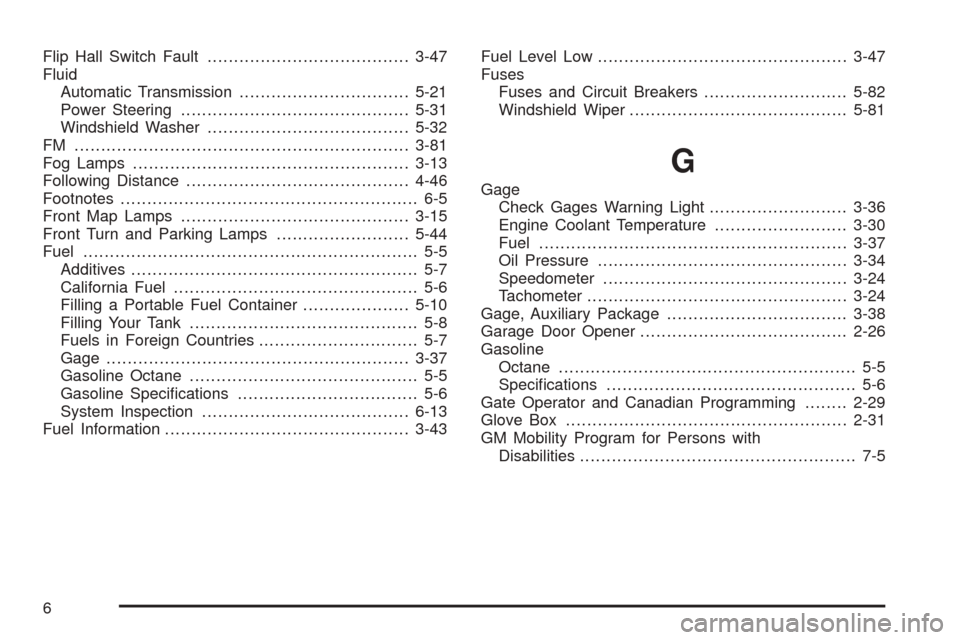
Flip Hall Switch Fault......................................3-47
Fluid
Automatic Transmission................................5-21
Power Steering...........................................5-31
Windshield Washer......................................5-32
FM ...............................................................3-81
Fog Lamps....................................................3-13
Following Distance..........................................4-46
Footnotes........................................................ 6-5
Front Map Lamps...........................................3-15
Front Turn and Parking Lamps.........................5-44
Fuel............................................................... 5-5
Additives...................................................... 5-7
California Fuel.............................................. 5-6
Filling a Portable Fuel Container....................5-10
Filling Your Tank........................................... 5-8
Fuels in Foreign Countries.............................. 5-7
Gage.........................................................3-37
Gasoline Octane........................................... 5-5
Gasoline Speci�cations.................................. 5-6
System Inspection.......................................6-13
Fuel Information..............................................3-43Fuel Level Low...............................................3-47
Fuses
Fuses and Circuit Breakers...........................5-82
Windshield Wiper.........................................5-81
G
Gage
Check Gages Warning Light..........................3-36
Engine Coolant Temperature.........................3-30
Fuel..........................................................3-37
Oil Pressure...............................................3-34
Speedometer..............................................3-24
Tachometer.................................................3-24
Gage, Auxiliary Package..................................3-38
Garage Door Opener.......................................2-26
Gasoline
Octane........................................................ 5-5
Speci�cations............................................... 5-6
Gate Operator and Canadian Programming........2-29
Glove Box.....................................................2-31
GM Mobility Program for Persons with
Disabilities.................................................... 7-5
6